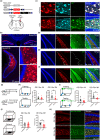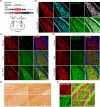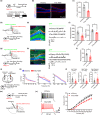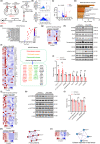Alzheimer-like tau accumulation in dentate gyrus mossy cells induces spatial cognitive deficits by disrupting multiple memory-related signaling and inhibiting local neural circuit
- PMID: 35355405
- PMCID: PMC9124302
- DOI: 10.1111/acel.13600
Alzheimer-like tau accumulation in dentate gyrus mossy cells induces spatial cognitive deficits by disrupting multiple memory-related signaling and inhibiting local neural circuit
Abstract
Abnormal tau accumulation and spatial memory loss constitute characteristic pathology and symptoms of Alzheimer disease (AD). Yet, the intrinsic connections and the mechanism between them are not fully understood. In the current study, we observed a prominent accumulation of the AD-like hyperphosphorylated and truncated tau (hTau N368) proteins in hippocampal dentate gyrus (DG) mossy cells of 3xTg-AD mice. Further investigation demonstrated that the ventral DG (vDG) mossy cell-specific overexpressing hTau for 3 months induced spatial cognitive deficits, while expressing hTau N368 for only 1 month caused remarkable spatial cognitive impairment with more prominent tau pathologies. By in vivo electrophysiological and optic fiber recording, we observed that the vDG mossy cell-specific overexpression of hTau N368 disrupted theta oscillations with local neural network inactivation in the dorsal DG subset, suggesting impairment of the ventral to dorsal neural circuit. The mossy cell-specific transcriptomic data revealed that multiple AD-associated signaling pathways were disrupted by hTau N368, including reduction of synapse-associated proteins, inhibition of AKT and activation of glycogen synthase kinase-3β. Importantly, chemogenetic activating mossy cells efficiently attenuated the hTau N368-induced spatial cognitive deficits. Together, our findings indicate that the mossy cell pathological tau accumulation could induce the AD-like spatial memory deficit by inhibiting the local neural network activity, which not only reveals new pathogenesis underlying the mossy cell-related spatial memory loss but also provides a mouse model of Mossy cell-specific hTau accumulation for drug development in AD and the related tauopathies.
Keywords: Alzheimer's disease; hTau N368; hippocampus; mossy cell; spatial memory.
© 2022 The Authors. Aging Cell published by Anatomical Society and John Wiley & Sons Ltd.
Conflict of interest statement
The authors declare no competing interests.
Figures






Similar articles
-
Medial septum tau accumulation induces spatial memory deficit via disrupting medial septum-hippocampus cholinergic pathway.Clin Transl Med. 2021 Jun;11(6):e428. doi: 10.1002/ctm2.428. Clin Transl Med. 2021. PMID: 34185417 Free PMC article.
-
Targeting a vulnerable septum-hippocampus cholinergic circuit in a critical time window ameliorates tau-impaired memory consolidation.Mol Neurodegener. 2023 Apr 14;18(1):23. doi: 10.1186/s13024-023-00614-7. Mol Neurodegener. 2023. PMID: 37060096 Free PMC article.
-
STAT3 ameliorates cognitive deficits via regulation of NMDAR expression in an Alzheimer's disease animal model.Theranostics. 2021 Mar 13;11(11):5511-5524. doi: 10.7150/thno.56541. eCollection 2021. Theranostics. 2021. PMID: 33859760 Free PMC article.
-
[Impaired cognitive map in transgenic animals relevant to Alzheimer's disease: from neurons to network].Sheng Li Xue Bao. 2023 Oct 25;75(5):671-681. Sheng Li Xue Bao. 2023. PMID: 37909138 Review. Chinese.
-
Illuminating Neural Circuits in Alzheimer's Disease.Neurosci Bull. 2021 Aug;37(8):1203-1217. doi: 10.1007/s12264-021-00716-6. Epub 2021 Jun 5. Neurosci Bull. 2021. PMID: 34089505 Free PMC article. Review.
Cited by
-
Dopamine D2 receptors in hilar mossy cells regulate excitatory transmission and hippocampal function.Proc Natl Acad Sci U S A. 2023 Dec 12;120(50):e2307509120. doi: 10.1073/pnas.2307509120. Epub 2023 Dec 8. Proc Natl Acad Sci U S A. 2023. PMID: 38064513 Free PMC article.
-
A novel transgenic mouse line with hippocampus-dominant and inducible expression of truncated human tau.Transl Neurodegener. 2023 Nov 10;12(1):51. doi: 10.1186/s40035-023-00379-5. Transl Neurodegener. 2023. PMID: 37950283 Free PMC article.
-
Dominant activities of fear engram cells in the dorsal dentate gyrus underlie fear generalization in mice.PLoS Biol. 2024 Jul 12;22(7):e3002679. doi: 10.1371/journal.pbio.3002679. eCollection 2024 Jul. PLoS Biol. 2024. PMID: 38995985 Free PMC article.
-
Tau truncation in the pathogenesis of Alzheimer's disease: a narrative review.Neural Regen Res. 2024 Jun 1;19(6):1221-1232. doi: 10.4103/1673-5374.385853. Epub 2023 Sep 22. Neural Regen Res. 2024. PMID: 37905868 Free PMC article.
-
Immunotherapy against tau fragment diminishes AD pathology, improving synaptic function and cognition.Mol Neurodegener. 2025 May 27;20(1):60. doi: 10.1186/s13024-025-00854-9. Mol Neurodegener. 2025. PMID: 40426267 Free PMC article.
References
-
- Botterill, J. J. , Lu, Y.‐L. , LaFrancois, J. J. , Bernstein, H. L. , Alcantara‐Gonzalez, D. , Jain, S. , Leary, P. , & Scharfman, H. E. (2019). An excitatory and epileptogenic effect of dentate gyrus mossy cells in a mouse model of epilepsy. Cell Reports, 29(9), 2875–2889.e2876. 10.1016/j.celrep.2019.10.100 - DOI - PMC - PubMed
Publication types
MeSH terms
Substances
LinkOut - more resources
Full Text Sources
Other Literature Sources
Medical

